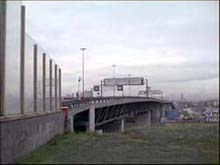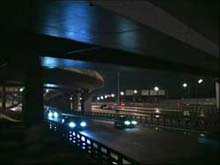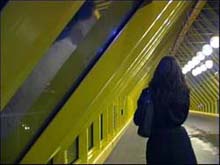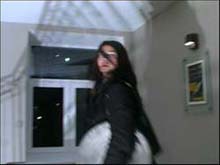Andrei Monastyrskiy talks to Nikolaj Sheptulin about his recent film “The Comforter” (Moscow, 2004)
Nikolai Sheptulin was born in 1969 in Moscow. He studied in the journalism department at Moscow State University where he specialized in English Romanticism, resulting in a translation of De Quincey’s “Confession” published in 1994 in Ad Marginem. In 1991 he founded the publication house (and gallery since 1994) Obscuri Viri, which published for the first time many texts of the Moscow Conceptual school, among them Sorokin’s “Norma” and “Roman,” as well as the journal Mesto Pechati. Since 2000 he has been a member of the Moscow Artists Union, working in film since 2002.
Introduction
The film deals with conceptual topics significant for a general framework of culture as well as for particular means of cinematography. Objects presented in a rhythm supported by ambient music are released from no particular place and time, from an unspecified “reality.” The main heroes are the light and the dark (day and night), the vertical and the horizontal, motion and stillness, before and after, upand down, beginning and end. At the same time, binary oppositions are continually in the process of divergence, oscillation and fluctuation. There are living creatures involved: the hedgehog, the mover without a cause and without attributes, and a woman – the severance of the order and the exponent of a new order, connected with the film-on-film semantic level. The Comforter evokes considerations about basic principles of formation, production, creation and mythopoeia – without any complete thesis or ideology. Moscow suburbs, surveyed from a fundamental distance, became an impetus for an open chain of contemplations. (Tomas Glanc, Prague)
A. M.: First, tell me, on which principle did you build the plot line? In the movie you first have morning, then daytime, evening, and night, all in the scene in the park in Sokolniki. What was your main subject? Day? Not round the clock, but precisely during daytime? According to the script, which interval of time is shown, after all?
N. S.: In the film there are four parts. The first is “Dawn,” then “Noon,” then “Dusk,” and finally, “Night” – the last part, which is consciously contrasted with the other parts and strongly differs from them. “Night” happens after the sunset, and is sometimes called “the American night.” In the film it is the space of artificial light, as well as of a few artificial, fictional actions. The beginning of the whole film that determines its structure is the formation and development of the day, and these are the reasons for a constant movement – the succession of days and nights. In the center of the film there is an uninterrupted succession of light and darkness, and that is the theme of the movie.
A. M.: You have beautifully presented that theme. During the beginning credits this alternation of light and darkness is conveyed very well, in a meditative key. When the camera, located in a vertical position, films the sky, and the bridges pass right above the camera (which is obviously located in a car), their long, dark lines contrast with the immobile whiteness of the sky. That scene, by the way, comes right after the puffed up clouds in the very beginning of the film. Was it clouds or smoke?
N. S.: If you mean the three-minute long prologue, there are at times the clouds, and at times, industrial smoke, only a close-up view of it.
A. M.: That means that the puffs of smoke in the very beginning are already intermixed with clouds? The reason I ask is because later in the film you have a few more instances where this image of huge smoking chimneys appears. The stacks of the electric power station obviously relates to the beginning, but in the prologue there are no chimney-stacks, and the smoke blends in with the clouds, forming a whole.
N. S.: You have noticed correctly. It was meant to be this way. The source of the clouds and the smoke is, on one hand nature, and on the other industry and technology. They are not juxtaposed, but on the contrary, tightly interconnected in the film.
A. M.: Is the poetic image of hedgehog in the film connected with it? Did you not, in fact, build everything based on that image?
N. S.: I had to show a certain reason for the general, universal, cosmic movement, the general cyclic recurrence. This reason could have not been a person, or a machine – it could have only been an animal, one deprived of any mythological associations at that….
A. M.: Yes, that is very true!
N. S.: If it had been a cat or a dog, it would have caused a superfluous chain of allusions right away. With the hedgehog, on the other hand, the viewer does not have any automatic associations, but, at the same time, it is recognizable – because a certain exotic animal would be out of place here as well. Besides, a hedgehog, curling itself up in a ball, forms a sphere, and in this way it is capable of embodying the idea of both movement and cyclic recurrence. light and darkness, and that is the theme of the movie.
A. M.: Yes, and in my opinion, the biggest achievement of this film is your ability to accurately and firmly pull apart two things. You separate the faktura – the texture of the film, that which is going on, the rotation and the movement, the passing of time – from the interpretative moment, from semiotics. Of course, that semiotic element was necessary for you, and you have inserted it in the form of milk-feeding at the end, and at the end the hedgehog jumps out of its wheel. However, you turn over that semiotic element and all the mythological moments to the technical part – after all, the girl pours milk into the tape case, into an accompanying technical detail. It is as if you turn over the whole semiotic to the accompanying technical equipment.
N. S.: I would say that I turned it over to the last part when the human being appears.
A. M.: Yes, in the three meditative parts you do not have even one human being. This is very important. Although, inconspicuously, the human is still present in the streaming traffic…Every car is driven by a human, although we do not see them. By the way, the girl in the forth part at first appears coming out of a car, as if the whole day she was secretly present on the screen in that traffic, and at night she enters into the light – that is also very fundamental. But for me, a very important thing is this: why is the film a film, and not video art? Video artists are always torn between semiotics and faktura, one gets stuck in another, one morphs out of the other; in other words, there are some torturous fissions going on. But in your case, there are very clear and obvious distinctions between semiotics and faktura, and that is what I liked most of all. The texture of the fabric is one thing, but semiotics and interpretation is another. The most basic thing, in my opinion, is that by using a powerful layer of myth and mythologisms (for instance, the images of milk and feeding are in and of themselves very powerful and intensive mythological images) you could have related this layer to the right place and left it there. That is, you have achieved a very accurate distinction between two absolutely different things. In your film one wants to trace its texture, its fabric, and this faktura-related subject is very gripping. At the same time, to trace the meaning of the film, to calculate what exactly it is or means, to build semantic structures is just not that important; you reduced that element considerably.
N. S.: I thought that the meditative part of the film would appeal not to the viewers’ intellect, but rather to their unconscious.
A. M.: Yes, but that is still the level of purely conscious impressions. In the film one is mostly interested in tracing nothing but movement – a very rare thing indeed.
N. S.: Yes, a rare thing, although at the same time, the fundamental function of film is to record movement. I wanted absolutize this, to portray movement in epic proportions. In my film, the technological, mechanic movement is, on one hand, the consequence of the movement of the heavenly bodies and planets. On the other hand, the movement of the sun across the sky is itself initiated by the movement of the wheel with the hedgehog-demiurge inside.
A. M.: It is also interesting to note that all of these semantic influxes appear already after the film, yet not in the viewer’s interpretation but in the film’s very structure – in how you have built the film, in its fabric. Look, there first appears a blue thread, which is then woven into the cloth on some drums. Then this cloth falls, unraveling, over the camera. In the last part, the whole room into which the girl enters turns out to be filled with this blue fabric. That fabric is basically the film that has already been filmed, rolled up onto the reel, and that has even been shown with a projector. All semantically relevant moments, such as the girl taking the reel into the forest, or her pouring milk, appear as if they occurred already after the film. This is a very interesting approach, and there is such incredible relief at the end. One does not sink into this meaning; it is not forced you. Rather, it is conveyed very lightly, through feeding, but that milk is somehow technically very well presented and disturbs absolutely nothing. In the last scene, there is no superfluous tension. At the beginning of the last scene I began to be overcome with a sense of danger when the girl appears and the music changes from delicate meditative tunes and Glass’s symphony to coarse tango.
N. S.: I wanted to create this feeling of a somewhat coarse vitality…
A. M.: Yes, precisely, vitality, but this was dangerous—it’s as if another register had been turned on. It’s if you got up to another level, and one thinks, “Well, now he will either twist his ankle, or fall, or something will not work out.” But no, you were able to rise up to the level of this meaning and understand this meaning, let the hedgehog out, and do everything well. That is, the achievement of this film consists in the fact that you managed to put all the large-scale, heterogeneous aesthetic blocks of this film together in such a way that a powerful, wholesome sensation was created.
N. S.: I would be interested to know how this film, for you, fits into the history of cinema.
A. M.: In the city panorama there is, probably, something of the films by Wenders.
N. S.: By Wenders? I didn’t think about it, to be honest, although may be it really does have something in common with the somewhat distanced shots of the city in Wings of Desire…
A. M.: And, of course, Dziga Vertov.
N. S.: Yes, but I’d rather say there is a polemics with Vetrov. There is almost not a single a person in my film, and, more importantly, there is no film camera. There is a projector, but no kino-eye, which for Vertov serves as the central image throughout the film. In my movie, the eye appears only during the first three minutes, in the prologue, in the clouds…it is somewhere very far away.
A. M.: Yes, Vertov in the sense of a polemics, of course. Afterwards I also had associations with Man Ray, with his photographs, but he is the same period as Vertov.
N. S.: Usually I am asked whether I have considered Ruttmann’s film Berlin – Symphony of a Great City. There is in fact a similar structure, a megalopolis from dawn to dusk, but in Ruttman’s film the mechanisms are inseparable from the people. They are shown solely as the projection of the people’s efforts; the people with their activity in all its manifestations create that symphony. The whole city is shown through the lives of the people.
A. M.: No, you have a totally different theme. Instead, one needs to look for the sources in meditative film, in the films put to the music of Glass. There must certainly be other analogues of which I am not aware.
N. S.: Tomas Glants told me that my film is reminiscent in some ways of a film by James Benning called Los. I have not seen it, and can only judge from its description. It is a series of alternating views filmed from different stationary points such as highways, streets, etc., but there is also some kind of three-minute-long, constant, unchanging structuring entity. I, on the other hand, wanted precisely to forget about the real tracking of time.
A. M.: Here one also needs to keep in mind the context. You were filming Moscow, weren’t you?
N. S.: Yes, but I was aiming to film it is such a way that it could be any city.
A. M.: And you have succeeded! It’s amazing that given the situation of cinema in Moscow and Russia these days you have succeeded in establishing such a colossal distance both from Moscow and from the movies that are made there, and to create through this Moscow an image of the city that is totally your own. Maybe the most important significance and achievement of this film is that in the muddy stream of everything that was filmed, you have managed to bring in such a bright note, a kind of Kammerton – this is very important! This is precisely why I said that the context needs to be taken into consideration so that both foreigners and locals can understand the aesthetic result. However, the locals will be forced to consider the context, while the foreigners…It will be important to observe how the people from abroad will perceive the movie.
N. S.: In Prague, Thomas Glants arranged for a public showing of this film to a small audience. Apart from the fact that, according to him, the film was very well received, I don’t know anything about this. According to him the viewers carried on lengthy discussions on the role and function of the girl. By the way, many have told me that the last part where she appears disturbs the general homogenous image of the film. Vladimir Sorokin also said that he liked the first three parts, but that the part with the girl falls, according to him, out of the rhythm of things. He said that humans don’t have a place there, in this picture of the world, they are superfluous.
A. M.: That’s a bigmistake! Moreover, if one takes on a more open mindset, it will become apparent that a huge achievement of the film consists precisely in that through that girl you could highlight even more strongly the preceding world. This is not a dead world. Apparently, Sorokin means that this world of cars, mechanisms, etc. – but it’s a world of movement, first and foremost, and not that of the machines! And the girl is also very dynamic, she is constantly in motion, and the camera follows her every move!
N. S.: She is static only during the projection of the film…
A. M.: Yes, you have that very well thought out, and I find this is a curiously simple perspective on the episode with the girl very superficial.
N. S.: I purposely created the last part to be this way, namely in order to highlight the previous ones.
A. M.: No, without that last part, there would not be anything at all. The whole point is that there is a sort of energetic spurt happening in that part– the film lifts itself up precisely because of it. It could have fallen, and maybe Sorokin took this part to mean the fall. I have already said that at the end you take a very dangerous turn, a turn through which the film could either fall or rise. I know for sure that this was a spurt, an upsurge, an uplift, a different platform, but not a fall, and the girl was assigned to a very correct place in this world. It is precisely because of this last part that the film begins to flow as if it was being played to notes. At the end the whole semiotics of the film is scattered like fireworks, but it is not scattered in a negative sense, like a house of cards, but like a salute, like something brilliant. It’s important that in that last scene with the empty carnival rides this semiotic scattering happens as something positive, like a flash of something very good, like joyful fireworks. At that point, one feels truly liberated…And that opinion that the girl kills everything might be justified from the point if view of popular cinema, but it does not have anything to do with great cinema. Your film, on the other hand, is directly related to that cinema. It represents a completely different worldview even if the general public may not perceive it the same way.
N. S.: Yes, many people like only the exterior technological coolness of the film that they see in the first three parts. But if I were to end with that, if I didn’t insert the part with the girl, it would have been video art.
A. M.: Absolutely! Without the last part the film would not have come into being. By the way, there isn’t even that much coolness in the main part of the film; there is movement, which is the main hero. One constantly follows the plot line of motion, and a very abstracted motion at that, and that is very interesting. Besides, you are not just showing some cold world, there is nothing of that nature in the film. The plot line for this semiotic flash at the end is constantly being created through these threads, the fabric. The fabric that fills up the room right before the final scene, that’s great. At the end there is no semiotics inside, no symbolism, but only fabric, faktura, the very movement itself, the text out of which the film was created. I understand the word “fabric” in every sense of the word, both like the cloth and like the essence of an art object. You have it all very well thought out. It is obvious that your task was not a panoramic view of some cold city, but an abstracted plot line of movement, even a very abstracted one. But every abstraction has its own compositional threads, and in your case, they are very well laid out, seen, and interesting to follow. This, perhaps, is in fact the most basic thing that happens in this film.
Moscow, July 15, 2004.
Postscript
This interview is the first in a series of talks about film and media in ARTMargins. The next piece will be about the film reality show “Cesky sen” / “Czech Dream” (2004) by Remunda and Klusak which was presented at several festivals this year ( including Karlovy Vary, Locarno, Leipzig, London Film Festival, Cottbus). In May 2003 the authors of the “provocumentary” lured thousands of people to a fictitious hypermarket in a field in the Prague outskirts with ads saying: “Don’t go there,” “Don’t spend,” “Don’t push.” When the shoppers came to the promised/forbidden Field of Czech Dream they found only a huge billboard on a scaffolding with the logo of “Cesky sen.” (www.ceskysen.cz)
Interview translated by Inna Stepanenenko; Sheptulin biography translated by Stacey Van Dahm.
The Comforter
2004, Russia, 33 min. Feature, Color
Cast credits:
Vera Alexeeva
Production credits:
Nikolai Sheptulin – Director / Cinematographer / Editor / Producer
Pavel Labasov – Producer / Production Manager
Alexander Korneev – Editor / Sound
Produced by Videodom (videodom@online.ru) / Nikolai Sheptulin
DVD available from videodom@online.ru
(Natascha Drubek-Meyer)










